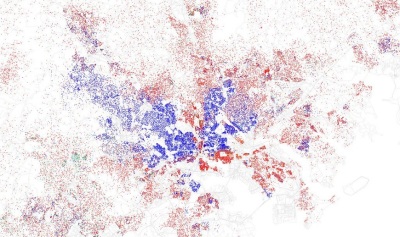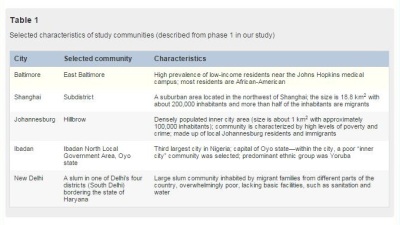Are parts of Baltimore third world? Should Christians care?

NASHVILLE, Tenn. (Christian Examiner) – Results from a study on the physical and social influences of a neighborhood on the health of very disadvantaged urban adolescents shockingly show 15- to 19-year-old teens in Baltimore, Maryland, had poorer health, higher rates of risky behaviors and held worse perceptions about their neighborhoods than peers in Shanghai, China and Ibadan, Nigeria.
The study focused on impoverished areas in these three cities as well as Johannesburg, South Africa, and New Delhi, India. Researchers surveyed target communities in all five cities and found similarities in unsanitary conditions, substance abuse and violence. But teens in Baltimore and Johannesburg were far less healthy and had more negative perceptions about their communities despite living in relatively wealthier countries than the rest of the participants in the research.
Of particular interest, the Johns Hopkins University study disclosed that compared to the other cities' youth, Baltimore adolescents were more likely to have sex and experienced higher rates of teen pregnancy, sexual violence, substance abuse and mental health issues.

Finding out the Baltimore teens in the study fared so poorly worldwide was particularly surprising because the participants were selected from residents in East Baltimore near the Johns Hopkins medical campus. Johns Hopkins University and its medical system are premier institutions of higher learning and pioneering research with state-of-the-art facilities. It is a wealthy enterprise, with the university listed among the top 25 U.S. schools in endowments.
Health experts propose that the driving force behind these behaviors is the teenagers' response to their surroundings in terms of the conditions of physical structures in the immediacy of their neighborhoods and also their sense of social cohesion and safety in this environment.
In essence what the findings described was a prevailing lack of hope in Baltimore inner city neighborhoods.
"How kids perceive their environments is really important," according to Kristin Mmari, an assistant professor in the Department of Population, Family and Reproductive Health at the Johns Hopkins Bloomberg School of Public Health. "That's what's driving many of these behaviors."
"Being poor is not the same everywhere," she added. "For young people living in poverty, residing in a high-income country seems to matter far less than the immediate surroundings in which they develop and grow," she concluded. A young man in New Delhi and a young man in Baltimore may both live in neighborhoods with poor living conditions and little opportunity, she told Vocative.com, but because the teenager in New Delhi is able to see his environment in more positive light, he is less likely to experience adverse health problems.
"He paints a different picture," according to Mmari.
In the last decade Baltimore has had the distinction of leading the United States in a number of negative categories that reflect or contribute to the hopelessness described in the study.
-- It is in the top ten of U.S. cities for HIV rates but ranks number 25 in population. Moreover, African-Americans are twice as likely as Latinos to be diagnosed HIV positive and four times more likely to be infected than Caucasians. Baltimore's population is 63 percent African-American.
-- Baltimore had the fifth highest murder rate in the country in 2013. Only Detroit, Newark, New Orleans and St. Louis had higher rates. The 233 homicides were more than the number in Houston, which has 2.18 million people compared to Baltimore's population of about 622,000.
-- Teen birth rates in the city are higher than in the state and the country.
-- At 25 percent, the poverty rate is nearly 10 percentage points above the national level and 15 points greater than in the state.
But the city also has the distinction of spiritual poverty as well.
In 2014, the Barna Group ranked Baltimore 68 out of 100 cities on Bible-mindedness, a metric that includes having read the Bible once in seven days and professing a strong belief in the accuracy of the Scripture. And lack of value for the Bible appears to correlate to the number of religious adherents in the city. Research about church affiliation does not break out data for cities, but the Association of Religion Data Archives, which conducts religious congregation and membership studies, reported that Maryland's percentage of the population having any faith tradition, 40.7, is well below (16.4 percent) the national average of 48.7 percent.
Baltimore also has one of the highest rates of fatherless homes in the nation.
Among cities with populations of 100,000 or more, Baltimore is sixth in the nation in the percentage of homes without a father (62 percent), and former Maryland Governor Robert L. Ehrlich Jr. called this fatherlessness an epidemic with frightening cultural consequences.
Noting that "not all fatherless homes suffer impoverishment or produce troubled children," in a 2012 column for The Baltimore Sun, he cited research linking this factor to a number of negative outcomes for adolescents – many the same as in the study. Homelessness, runaways, dropouts, premarital births, drug and alcohol abuse he said are "daunting obstacles" for success in life, and all have strong correlations with fatherlessness.
The Johns Hopkins study did not address spiritual factors, but Mmari said fatherlessness was a factor in both Baltimore and Johannesburg, whose teens reported some of the worst outcomes and negative outlooks.
"In those cities, kids were much more likely to live in a one-parent household," she said, according to Vocativ.com. "Whereas in Delhi, most of these kids are still living in two-parent homes, so they are getting much more support."
"When you think about poor adolescents, you may instantly think of a child in Africa because there are poorer countries there, but it's not really the country that is important," Mmari observed. "Right here in Baltimore, we have kids who are much worse off than those in African cities."
Not all the news about Baltimore teens is negative.
In a January statement from Mayor Stephanie Rawlings-Blake, data showed a three year improving trend in graduation and dropout rates. The four-year graduation rate for the class of 2013 was 68.5 percent, a seven point jump, or 11 percent, from the 61.5 percent who graduated with the class of 2010. The dropout rate showed even more progress, going from 23.8 percent to 12.1 percent.
"1,530 members of the class of 2010 dropped out of school, compared to 726 members of the class of 2013," the press release noted. "This represents a 52.5 percent decrease, and an unequivocal change in direction for the district."